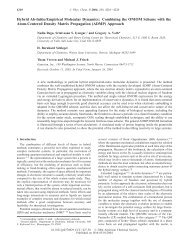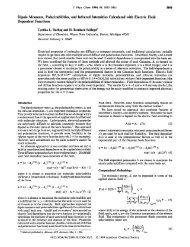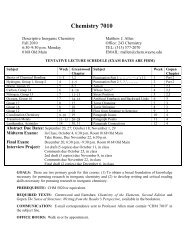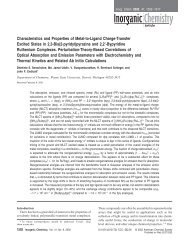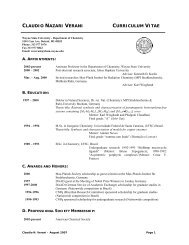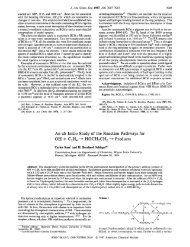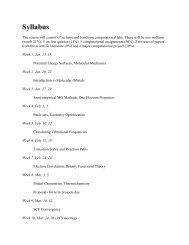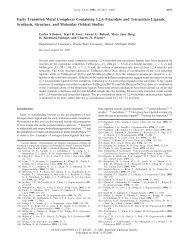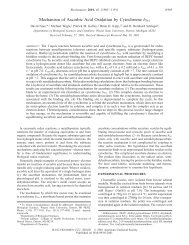A toolkit to assist ONIOM calculations - Department of Chemistry ...
A toolkit to assist ONIOM calculations - Department of Chemistry ...
A toolkit to assist ONIOM calculations - Department of Chemistry ...
Create successful ePaper yourself
Turn your PDF publications into a flip-book with our unique Google optimized e-Paper software.
A Toolkit <strong>to</strong> Assist <strong>ONIOM</strong> Calculations<br />
2367<br />
<strong>ONIOM</strong> Production Jobs<br />
Once key structures in a reaction sequence (e.g., reactant, product,<br />
TS, etc.) are identified, final production <strong>calculations</strong> need <strong>to</strong><br />
be carried out. If a reduced <strong>ONIOM</strong> model system was generated,<br />
the structures found for the model system must be reoptimized<br />
for the whole system. New input files for optimizing the<br />
whole system can be generated from the optimized geometries<br />
<strong>of</strong> the reduced model.<br />
Another issue that needs <strong>to</strong> be addressed is the MM partial<br />
charges for a<strong>to</strong>ms in the QM region. For <strong>ONIOM</strong> <strong>calculations</strong>,<br />
the MM force field is required for the entire system, including<br />
QM region. The MM force field includes parameters for bond<br />
and nonbond interactions and partial charges. Because <strong>of</strong> its subtractive<br />
nature, most bond and short-range nonbond terms <strong>of</strong> the<br />
QM region cancel in the <strong>ONIOM</strong> final energy, but the electrostatic<br />
interactions between the QM and MM regions remain. In<br />
the ME scheme for <strong>ONIOM</strong> <strong>calculations</strong>, the electrostatic interactions<br />
between the QM and MM regions are calculated at the<br />
MM level based on the partial charges. Therefore, it is critical<br />
that the partial charges accurately reflect the charge distribution<br />
<strong>of</strong> the QM region. In the EE scheme for <strong>ONIOM</strong> <strong>calculations</strong>,<br />
the partial charges <strong>of</strong> the MM a<strong>to</strong>ms are included in the Hamil<strong>to</strong>nian<br />
<strong>of</strong> the QM region, and the MM partial charges <strong>of</strong> the QM<br />
a<strong>to</strong>ms play a less important role in the <strong>to</strong>tal energy than in the<br />
ME scheme. However, <strong>ONIOM</strong> geometry optimization <strong>calculations</strong><br />
using the EE scheme are generally more expensive than<br />
those with the ME scheme, especially for TS searching.<br />
Therefore, conducting ME <strong>ONIOM</strong> geometry optimization <strong>calculations</strong><br />
accurately is still a common and practical approach at<br />
present. When studying different structures in a reaction<br />
sequence, the charge distribution <strong>of</strong> the whole system changes,<br />
and a convenient method is needed for dealing with the changes<br />
in the charge distribution in a reaction sequence.<br />
The partial charges <strong>of</strong> natural amino acids and nucleosides<br />
are <strong>of</strong>ten taken from the AMBER force field. The partial charges<br />
for ligands are usually obtained from a charge-fitting process.<br />
One <strong>of</strong> the common procedures for charge fitting is the RESP<br />
method, 30,31 which was also used in the AMBER force field development.<br />
It would seem straightforward <strong>to</strong> obtain partial<br />
charges for the reactant and product and use them in QM/MM<br />
<strong>calculations</strong>. However, in many enzymatic systems, key amino<br />
acid residue side chains may form covalents bond with the substrate<br />
or may become pro<strong>to</strong>nated/depro<strong>to</strong>nated along the reaction<br />
path. In these cases, the charge distributions <strong>of</strong> substrate and residues<br />
at active site are strongly coupled. Not only the partial<br />
charges <strong>of</strong> the substrate but also those <strong>of</strong> the key residues in the<br />
active site <strong>of</strong> the protein need <strong>to</strong> be refitted in a reaction<br />
sequence <strong>to</strong> accurately reflect the structural changes.<br />
Tools for <strong>ONIOM</strong> Production Jobs<br />
A program transgeom is available <strong>to</strong> generate an <strong>ONIOM</strong> input<br />
file for the full system containing geometry from a reduced<br />
model system. This program matches each a<strong>to</strong>m from the model<br />
system <strong>to</strong> its counterpart in the full system <strong>to</strong> create a job file<br />
for the full system with the model system geometry. This program<br />
also has the ability <strong>to</strong> retain the a<strong>to</strong>m types, partial<br />
charges, optimization flags, and layer information from the<br />
model system, in case any <strong>of</strong> this setup information has been<br />
modified during preliminary study using the model system. With<br />
the optimized geometry from the model system, <strong>ONIOM</strong> optimization<br />
jobs for the full system generated by transgeom should<br />
converge rapidly. This program can also extract geometry from<br />
a full size model and build a partial model. In cases where a full<br />
frequency analysis is computationally prohibitive for the full<br />
size model but is affordable for a partial model, transgeom can<br />
be used <strong>to</strong> prepare the partial model input file with geometry<br />
from the full model. 32<br />
A program oniomresp is available <strong>to</strong> facilitate the fitting <strong>of</strong> a<br />
new set <strong>of</strong> partial charges for the QM region. This program is<br />
designed <strong>to</strong> apply the RESP charge-fitting pro<strong>to</strong>col <strong>to</strong> be compatible<br />
with the AMBER force field, but other types <strong>of</strong> partial<br />
charges from quantum chemistry <strong>calculations</strong> can also be used.<br />
This program needs an <strong>ONIOM</strong> output file as input, because the<br />
coordinates <strong>of</strong> capping a<strong>to</strong>ms (hydrogen in most cases) are<br />
needed in the charge-fitting calculation. This program works in<br />
three modes. Mode 1 generates a pure QM Gaussian input file<br />
for the QM region with capping a<strong>to</strong>ms from the <strong>ONIOM</strong> output<br />
file. This input file can be used <strong>to</strong> run a QM single point calculation<br />
for charge fitting. In mode 2, an input file for the RESP<br />
program is generated based on the QM single point calculation<br />
output file for the charge fitting. If there are any capping a<strong>to</strong>ms,<br />
it is recommended that they be constrained <strong>to</strong> have partial<br />
charges <strong>of</strong> zero. In this manner, the sum <strong>of</strong> the partial charges<br />
in the QM region will be constant and consistent for all the QM/<br />
MM <strong>calculations</strong>. This can be easily done by using a flag for the<br />
number <strong>of</strong> capping a<strong>to</strong>ms. The zero charge constraint will be<br />
added au<strong>to</strong>matically <strong>to</strong> all the capping a<strong>to</strong>ms in the input file<br />
generated for the RESP calculation. In mode 3, a new <strong>ONIOM</strong><br />
input file is generated with the partial charges <strong>of</strong> the QM region<br />
replaced by the RESP charges. Before using mode 3, an <strong>ONIOM</strong><br />
input file should be generated from the <strong>ONIOM</strong> output file used<br />
for mode 1. The program oniomlog can be used for this purpose.<br />
This <strong>ONIOM</strong> input file contains the optimized geometry from<br />
the output file and the old partial charges. This <strong>ONIOM</strong> input<br />
file and the new partial charges fitted for the QM region by<br />
RESP are input files in mode 3 <strong>to</strong> generate an <strong>ONIOM</strong> input file<br />
with the new RESP partial charges. The newly generated<br />
<strong>ONIOM</strong> input file can be used for further QM/MM geometry<br />
optimization calculation.<br />
In some cases, the user may want <strong>to</strong> refit the partial charges<br />
for different parts <strong>of</strong> the system other than the QM region.<br />
Mode 3 <strong>of</strong> oniomresp can fulfill this purpose by using a map file<br />
<strong>to</strong> match each charge <strong>to</strong> the corresponding a<strong>to</strong>m in the <strong>ONIOM</strong><br />
input file. Besides RESP, other types <strong>of</strong> a<strong>to</strong>mic charges, such as<br />
APT, NPA, or Mulliken, could be used in <strong>ONIOM</strong> <strong>calculations</strong>.<br />
Program extractcharge is designed <strong>to</strong> extract partial charges<br />
from a QM calculation and <strong>to</strong> save <strong>to</strong> a file for use with mode 3<br />
<strong>of</strong> oniomresp.<br />
It is obvious that optimization <strong>of</strong> an input file generated with<br />
mode 3 <strong>of</strong> oniomresp will lead <strong>to</strong> a different geometry. It is intuitive<br />
<strong>to</strong> repeat the charge-fitting process after the new optimization<br />
calculation. This iterative procedure can be repeated until<br />
convergence. A well-defined convergence threshold is that the<br />
Journal <strong>of</strong> Computational <strong>Chemistry</strong><br />
DOI 10.1002/jcc



